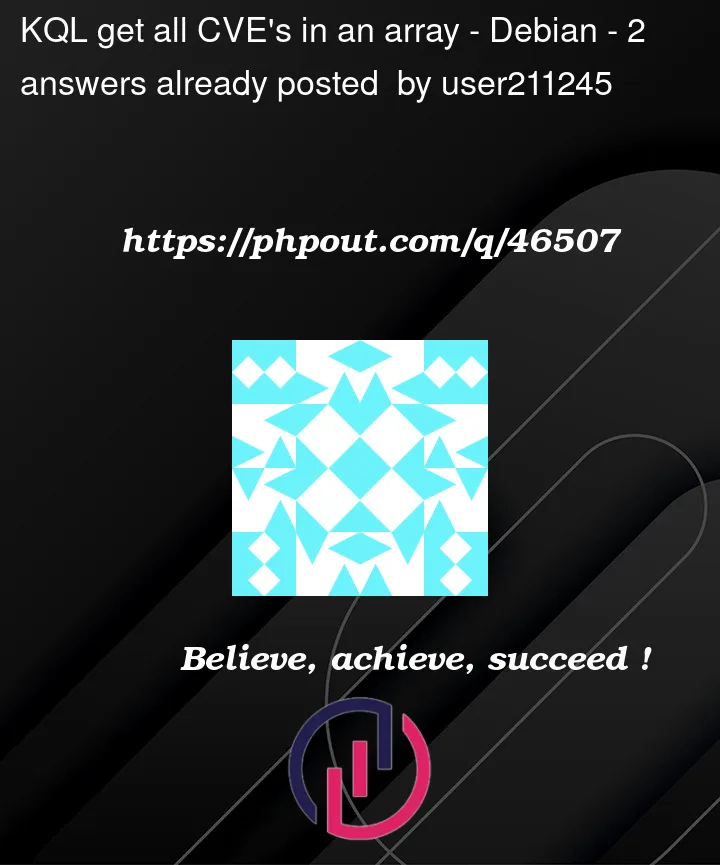I’m running the following KQL query in Azure Graph Explorer
securityresources
| where type == "microsoft.security/assessments/subassessments"
| extend assessmentKey = extract(".*assessments/(.+?)/.*",1, id)
| where assessmentKey == "dbd0cb49-b563-45e7-9724-889e799fa648"
This returns my raws with [Results][1]
If I click on See details I can see that a given vulnerability has 2 CVE’s assigned (CVE-2020-25709 and CVE-2020-25710)
{
"description": "Debian has released security update for openldap to fix the vulnerabilities.<P>",
"displayName": "Debian Security Update for openldap (DLA 2481-1)",
"resourceDetails": {
"id": "/repositories/foo/images/sha256:fb47732ef36b285b1f3fbda69ab8411a430b1dc43823ae33d5992f0295c945f4",
"source": "Azure"
},
"additionalData": {
"assessedResourceType": "ContainerRegistryVulnerability",
"vendorReferences": [
{
"title": "DLA 2481-1",
"link": "https://lists.debian.org/debian-lts-announce/2020/12/msg00008.html"
}
],
"publishedTime": "2020-12-09T13:44:37.0000000Z",
"repositoryName": "foo",
"metadata": {
"isPreview": false
},
"registryHost": "acrtestdev2.azurecr.io",
"patchable": true,
"imageDigest": "sha256:fb47732ef36b285b1f3fbda69ab8411a430b1dc43823ae33d5992f0295c945f4",
"cicdData": {
"status": "Incomplete"
},
"scanner": "Trivy",
"type": "Vulnerability",
"cvss": {
"2.0": {
"cvssVectorString": "CVSS:2.0/AV:N/AC:L/Au:N/C:N/I:N/A:P/E:U/RL:OF/RC:C",
"base": 5
},
"3.0": {
"cvssVectorString": "CVSS:3.1/AV:N/AC:L/PR:N/UI:N/S:U/C:N/I:N/A:H/E:U/RL:O/RC:C",
"base": 7.5
}
},
"cve": [
{
"title": "CVE-2020-25709",
"link": "http://cve.mitre.org/cgi-bin/cvename.cgi?name=CVE-2020-25709"
},
{
"title": "CVE-2020-25710",
"link": "http://cve.mitre.org/cgi-bin/cvename.cgi?name=CVE-2020-25710"
}
],
"imageDetails": {
"osDetails": "Debian Linux 9.3",
"os": "Linux"
}
},
"timeGenerated": "2022-08-11T08:58:48.5588955Z",
"status": {
"severity": "Medium",
"code": "Unhealthy"
},
"remediation": "Refer to Debian LTS Announce <A HREF="https://lists.debian.org/debian-lts-announce/2020/12/msg00008.html" TARGET="_blank">DLA 2481-1</A> to address this issue and obtain further details.n<P>Patch:<BR>nFollowing are links for downloading patches to fix the vulnerabilities:n<P> <A HREF="https://lists.debian.org/debian-lts-announce/2020/12/msg00008.html" TARGET="_blank">DLA 2481-1:Debian</A>",
"id": "178251",
"category": "Debian",
"impact": "Successful exploitation allows attacker to compromise the system."
}
How could I access that two values in the CVE array/list and output them in a single column, say CVE?
Thanks a lot for help on this !
[1]: https://i.stack.imgur.com/n6PH2.png




2
Answers
extract().properties.additionalData.cvearray.titleseem to be a special word, so usecve["title"](instead ofcve.title, which results in syntax error).I used a part from the query above and used it to build the following: